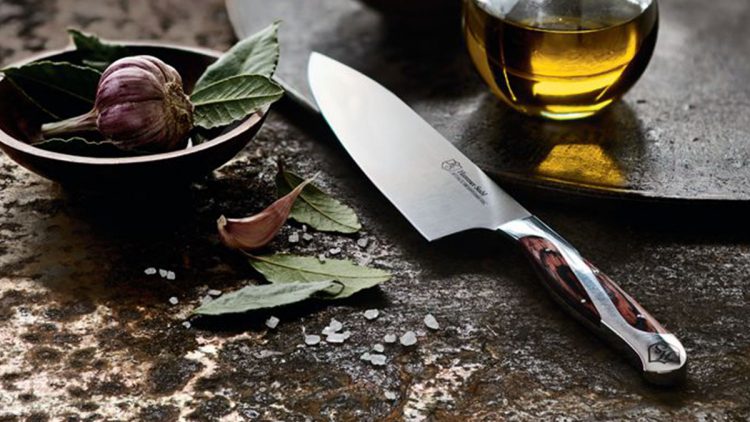You just wanted a good knife for everyday use and now you’ve found yourself staring at a gigantic wall full of cutlery you didn’t even know existed — boning knives, filet knives, bread knives, paring knives and even special knives for cheese — and the selection can get overwhelming quickly.
If the variety of knives wasn’t confusing enough, now you have to figure out what the difference is in style between Japanese and German knives, two of the major styles in the marketplace. Is there even a difference?
“The primary difference is hardness and thickness of the steel. German steel tends to be around 55 to 58 in Rockwell Hardness and Japanese steel is typically 59 to 62. The increased hardness allows for thinner blades and steeper angles,” says Bobby Griggs, vice president at Hammer Stahl cutlery, which produces knives in Germany.
There is a difference in construction too, says Emily Wann, national training manager for Global Cutlery USA. This may make a difference in comfort, which could impact ease of use.
“German knives often have a full tang and a bolstered handle, making them fairly heavy and substantial in the hand. Japanese knives can have a full tang but often don’t, resulting in a lighter knife overall that can have a lighter weight handle made of stainless steel or wood without the need for bolsters and rivets,” she explains.
Weight is a matter of personal preference and comfort, but Wann explains that for people who prefer a lightweight knife that’s easy to control and helps to avoid wrist/hand fatigue, Japanese knives are ideal.
Getting down to the business of slicing and dicing, there is a major difference between the two types of blades — German steel blades are thicker, while Japanese-style knives are more precise than their European counterparts.
Adds Harald Wüsthof, CEO of Wüsthof, “Japanese knives are often hand-honed and hand-refined and the blades are thinner, allowing for a sharper edge that needs to be sharpened more often. German knives have an edge of around 20 degrees, whereas Japanese knives tend to range from 15 to 16 degrees. This creates a slightly thicker blade in German knives, accounting for the change in edge.”
He explains that German and Japanese knives fall into varying categories based on what they are best at enhancing in the kitchen. The German knife can handle chopping, cutting and slicing and can be used throughout the entirety of the prep and cooking process. Japanese knives are ideal for smooth slicing and delicate knife tasks.
Wann, however, says that either knife can be used for any type of kitchen jobs, although there are specific benefits to using each knife.
“Both German and Japanese knives will get just about any job in the kitchen done, but Japanese blades tend to offer better precision thanks to their thin, sharp blade edges that are designed to hold their sharpness,” says Wann, while Griggs notes Japanese knives are great for sushi, sashimi and micro greens.
While German knives may be heavier in weight, they are a bit lighter on the maintenance side, says Griggs. He explains if you’re looking for a knife that is a kitchen workhorse but doesn’t need a lot of extra upkeep, a German knife may be your best bet.
“A German knife is easier to maintain. It holds an edge exceptionally well and holds up to the demands of kitchen. The Japanese knife needs a little more care and maintenance,” he says.
But, notes Wann, every knife — German or Japanese — needs to be properly maintained for longevity. This includes regular sharpening by yourself or a professional; using a honing steel in-between sharpenings; and proper washing and drying techniques.
“Never put your knives in the dishwasher, and always keep your blade dry and clean of food residues to avoid rust or oxidization. A good knife will last a lifetime if you take care of it properly,” says Wann.

